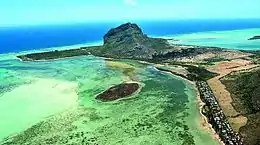Le Morne Brabant
Le Morne Brabant is a peninsula at the extreme southwestern tip of the Indian Ocean island of Mauritius on the western side of the island. It is highlighted by an eponymous basaltic monolith with a summit 556 metres (1,824 ft) above sea level. The summit covers an area of over 12 hectares (30 acres). There are many caves and overhangs on the steep slopes. It is largely surrounded by a lagoon and is a well known tourist attraction. It is also a refuge for two rare plants, the Mandrinette and the Boucle d'Oreille. The mountain is named after the VOC-ship (Dutch East India Company) Brabant that ran aground there on 29 December 1783 on the cliffs.
| UNESCO World Heritage Site | |
|---|---|
 Le Morne Peninsula | |
| Location | Mauritius |
| Criteria | Cultural: (iii), (vi) |
| Reference | 1259bis |
| Inscription | 2008 (32nd session) |
| Extensions | 2011 |
| Area | 349.6 ha (864 acres) |
| Buffer zone | 2,405 ha (5,940 acres) |
| Coordinates | 20°27′7″S 57°19′42″E |
 Location of Le Morne Brabant in Mauritius | |
The peninsula of Le Morne benefits from a micro-climate. Le Morne Brabant Mountain was submitted to the candidate list of the World Heritage sites in 2003. In 2008, the nomination process concluded when UNESCO inscribed the site on the World Heritage List.[1]
Peninsula

The peninsula is steeped in cultural "myth and legend" in the early 19th century as a suggested refuge for Maroons and people who escaped slavery. After the abolition of slavery in Mauritius, on 1 February 1835 it is rumored that a police expedition was dispatched there ostensibly to inform those who escaped slavery that emancipation had made them legally free men and women. The arrival of the police at the base of the mountain was (according to legend) misinterpreted by the former slaves who had scrambled to the summit (fearing that they were to be arrested and re-enslaved) and subsequently elected to leap to their deaths from the rock and commit suicide by landing in the ocean, rather than be recaptured back into slavery.[2] Since 1987 the date is celebrated (particularly by Mauritian creoles) as the Annual Commemoration of the Abolition of Slavery.
Le Morne has been declared a World Heritage Site. The monument includes an inscription of this extract from the poem "Le Morne Territoire Marron" by Richard Sedley Assonne; "There were hundreds of them, but my people the maroons chose the kiss of death over the chains of slavery."
Cultural and aesthetic impact
.jpg.webp)
With Aapravasi Ghat, the first World Heritage site of Mauritius, Le Morne highlights the historical significance of slavery and indenture, two labour systems that shaped modern Mauritius. It is a unique conjunction in the Indian Ocean and abroad, and UNESCO has promoted a symbolic meeting of those two systems, to foster a better understanding among the descendants of both the slaves and indentured labourers in the colonial plantation system.
Poet Khal Torabully, who developed the concept of coolitude, springing from intercultural strata of his native island, dreams that the memories of indenture and slavery will enhance debate on identity in Mauritius and elsewhere. For him Le Morne Brabant and the Aapravasi Ghat have to be considered as two characters of a collective narrative that will enhance openness and exchanges between cultures and dispel exclusive and sectarian views of identities.[3]
Further reading
Notes
- Centre, UNESCO World Heritage. "Le Morne Cultural Landscape". UNESCO World Heritage Centre.
- "Slave Route Monument". Atlas Obscura.
- "Coolitude", Wikipedia, 2020-03-24, retrieved 2020-05-06
External links
 Media related to Le Morne Brabant at Wikimedia Commons
Media related to Le Morne Brabant at Wikimedia Commons- Le Morne Brabant: The heritage of the Mauritian nation
- UNESCO World Heritage Centre – Le Morne Brabant
- Le Morne Heritage Trust Fund
- Le Morne et le ghat (in French)
- Views from La Rose des Vents – Le Morne Brabant (in French)
- Khal Torabully : Le Morne, le Ghat et l'Unesco (in French)